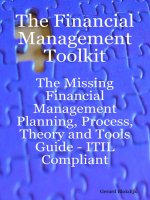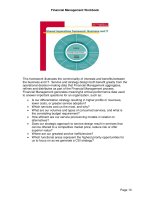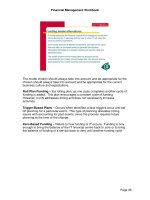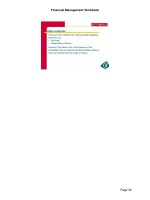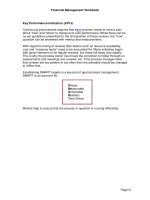Trade and Transport Corridor Management Toolkit
Bạn đang xem bản rút gọn của tài liệu. Xem và tải ngay bản đầy đủ của tài liệu tại đây (4.11 MB, 411 trang )
Trade and
Transport Corridor
Management
Toolkit
Trade and
Transport Corridor
Management
Toolkit
Charles Kunaka
Robin Carruthers
© 2014 International Bank for Reconstruction and Development / The World Bank
1818 H Street NW, Washington DC 20433
Telephone: 202-473-1000; Internet: www.worldbank.org
Some rights reserved
1 2 3 4 17 16 15 14
This work is a product of the staff of The World Bank with external contributions. The findings, interpretations, and conclusions
expressed in this work do not necessarily reflect the views of The World Bank, its Board of Executive Directors, or the governments
they represent. The World Bank does not guarantee the accuracy of the data included in this work. The boundaries, colors, denominations, and other information shown on any map in this work do not imply any judgment on the part of The World Bank concerning
the legal status of any territory or the endorsement or acceptance of such boundaries.
Nothing herein shall constitute or be considered to be a limitation upon or waiver of the privileges and immunities of The World
Bank, all of which are specifically reserved.
Rights and Permissions
This work is available under the Creative Commons Attribution 3.0 IGO license (CC BY 3.0) />/by/3.0igo. Under the Creative Commons Attribution license, you are free to copy, distribute, transmit, and adapt this work, including
for commercial purposes, under the following conditions:
Attribution—Please cite the work as follows: Kunaka, Charles, and Robin Carruthers. 2014. Trade and Transport Corridor
Management Toolkit. Washington, DC: World Bank. doi: 10.1596/978-1-4648-0143-3. License: Creative Commons Attribution
CC BY 3.0 IGO
Translations—If you create a translation of this work, please add the following disclaimer along with the attribution: This translation
was not created by The World Bank and should not be considered an official World Bank translation. The World Bank shall not be
liable for any content or error in this translation.
Adaptations—If you create an adaptation of this work, please add the following disclaimer along with the attribution: This is an
adaptation of an original work by The World Bank. Responsibility for the views and opinions expressed in the adaptation rests solely
with the author or authors of the adaptation and are not endorsed by The World Bank.
Third-party content—The World Bank does not necessarily own each component of the content contained within the work. The
World Bank therefore does not warrant that the use of any third-party-owned individual component or part contained in the
work will not infringe on the rights of those third parties. The risk of claims resulting from such infringement rests solely with
you. If you wish to re-use a component of the work, it is your responsibility to determine whether permission is needed for that
re-use and to obtain permission from the copyright owner. Examples of components can include, but are not limited to, tables,
figures, or images.
All queries on rights and licenses should be addressed to the Publishing and Knowledge Division, The World Bank, 1818 H Street NW,
Washington, DC 20433, USA; fax: 202-522-2625; e-mail:
ISBN (paper): 978-1-4648-0143-3
ISBN (electronic): 978-1-4648-0144-0
DOI: 10.1596/978-1-4648-0143-3
Cover design: Debra Naylor, Naylor Design, Inc.
Library of Congress Cataloging-in-Publication Data
Kunaka, Charles.
Trade and transport corridor management toolkit / Charles Kunaka, Robin Carruthers.
pages cm
Includes bibliographical references and index.
ISBN 978-1-4648-0143-3—ISBN 978-1-4648-0144-0
1. Transportation corridors—Planning. 2. Trade routes—Planning. 3. Business logistics. I. Carruthers, Robin. II. Title.
HE323.K86 2014
388.3'242—dc23
2014001154
CONTENTS
Foreword
Acknowledgments
About the Authors
Abbreviations
Introduction. Purpose and Use of This Toolkit
xiii
xv
xvii
xix
1
Why a Toolkit?
Organization of the Toolkit
References
2
6
11
Primer
13
Drivers of Corridor Development
Components and Functions of a Corridor
Note
References
Resources
13
16
25
25
26
PART I Corridor Diagnostic and Performance
Assessment
29
Module 1. Carrying Out a Corridor Diagnostic
31
Setting the Objective
Conducting a Strategic Assessment
Assessing Corridor Infrastructure
Assessing Logistics Services
32
32
39
40
v
vi
Executing a Corridor-Level Assessment
Tools for Conducting a Corridor Assessment
Summary of Corridor Assessment Techniques
Prioritizing Interventions
Annex 1A Defining and Collecting Data for a Corridor Diagnostic
Annex 1B Questions for Discussions with Logistics Providers,
Exporters, Importers, Distributors, and Wholesalers
Notes
References
Resources
43
44
52
53
54
62
68
69
69
Module 2. Assessing the Legal and Regulatory Context
of a Corridor
73
Collaboration, Cooperation, and Management
Hierarchy of Instruments
Analysis of Legal Instruments
Notes
Reference
Resource
74
75
87
90
91
91
Module 3. Institutional Arrangements for Corridor
Management
93
Why Is Corridor Management Relevant?
Types of Corridor Management Mechanisms
Main Activities of Corridor Management Bodies
Key Considerations in Corridor Management
Summary of Possible Interventions for Improving Corridor
Management
References
Resources
93
94
95
95
106
108
108
Module 4. Corridor Performance Indicators
111
Uses of Corridor Monitoring and Indicators
Levels of Decision Making
Characteristics of Indicators
Parameters to Monitor
Comparative Analysis of Corridor Performance
Notes
References
Resources
112
115
119
126
134
136
137
138
Trade and Transport Corridor Management Toolkit
PART II Improving Corridor Performance
139
Module 5. Border Management in a Corridor
141
Border Issues Affecting Corridor Performance
Data and Information Sources
Improving Border-Crossing Performance
Summary of Possible Interventions for Improving Border
Management
Annex 5A Flow Chart for Beitbridge Border Post (Cargo Inward),
Zimbabwe
Annex 5B Questions for Discussion of Customs
References
Resources
143
147
154
164
166
167
174
174
Module 6. Customs Transit Regimes
177
Overview of Customs Transit Regimes
Transit Issues in Developing Countries
Data and Information Sources
Improving Customs Transit Regimes
Summary of Possible Interventions for Improving Transit Regimes
Notes
References
Resources
178
181
184
184
194
196
196
197
Module 7. Road Freight Transport
199
Important Considerations along Corridors
Data and Information Sources
Improving Trucking Services within a Corridor
Summary of Possible Interventions for Improving Trucking Services
Annex 7A Questions for Discussion of Road Transport
Notes
References
Resources
201
215
217
223
225
235
235
235
Module 8. Rail Transport
239
Rail Freight Issues in a Trade Corridor
Data and Information Sources
Potential Improvement Measures
Summary of Possible Interventions for Improving Rail Transport
Annex 8A Questions for Discussion of Rail Transport
Notes
240
247
247
252
254
260
Contents
vii
viii
References
Resources
260
260
Module 9. Shipping and Maritime Transport
261
Types of Container Services
Data and Information Sources
Adapting to Changes in Maritime Shipping
Summary of Possible Interventions for Improving Maritime
Transport Services
Annex 9A Questions for Discussion of Shipping and Maritime Transport
Note
References
Resources
262
266
269
Module 10. Port Operations
281
Main Issues Relating to Ports and Corridor Performance
Data and Information Sources
Potential Solutions to Ports Issues
Summary of Possible Interventions for Improving Port Operations
Annex 10A Questions for Discussion of Port Operations
Note
References
Resources
282
289
292
296
298
302
302
303
Module 11. Land Access to Ports
307
Impact of Urban Access on the Functioning of the Port
Data and Information Sources
Options for Improving Land Access to Ports
Summary of Possible Interventions for Improving Land Access to Ports
Annex 11A Questions for Discussion of Land Access to Ports
Notes
References
Resources
309
311
311
316
318
322
322
323
Module 12. Airfreight
325
Airfreight Issues in Corridor Operations
Data and Information Sources
Improving Airfreight in a Corridor
Summary of Possible Interventions for Improving Airfreight
Annex 12A Questions for Discussion of Airfreight
Notes
326
331
332
337
339
342
272
274
277
278
278
Trade and Transport Corridor Management Toolkit
References
Resources
PART III Corridor Impact Evaluation
343
343
345
Module 13. Evaluating the Economic Impact of a Corridor
347
Objectives of Impact Evaluation
Criteria for Evaluation
Issues to Consider in an Impact Evaluation
Economic Evaluation Methods
Notes
References
Resources
349
349
350
352
362
362
363
Index
367
Boxes
I.1
P.1
P.2
1.1
1.2
1.3
1.4
4.1
5.1
5.2
5.3
5.4
6.1
7.1
7.2
7.3
7.4
Contents
Lessons from Corridor and Regional Projects by the
World Bank
Integrated Corridor Development in Maputo
Example of Impact of a Corridor on Supply Chain Organization
Conducting a Trade and Transport Facilitation Assessment
of a Regional Program in the Mashreq
Using Trip Diaries to Improve Trade along the Silk Road
Using Global Positioning System Data in Corridor Monitoring
Conducting Corridor Observatory Work in Africa
CIF versus FOB in West Africa
Using the Results of a Time Release Study on Border
Operations in Uganda
Monitoring Performance on the Border between Zambia
and Zimbabwe
Singapore’s Single Window
Reducing Delays by Sharing Customs Information in
East Africa
The European Community and Common Transit Systems
Cost of Monopoly in Trucking: Evidence from Nepal
The European Conference of Ministers of Transport
Multilateral Quota System
The Green Card Insurance System
Modernizing Trucking in Pakistan
3
22
24
42
48
50
51
116
149
153
158
159
191
203
207
210
219
ix
7.5
8.1
8.2
8.3
8.4
10.1
11.1
11.2
12.1
12.2
13.1
13.2
Deregulating the Trucking Industry: Lessons from
Mexico and Eastern Europe
Breaking up and Coordinating Railways in Central Asia
Mali’s Mango Exports
Joint Concessioning of Railways in East Africa
Inland Container Depots in Nepal
Using a Community of Users to Address Operational
Challenges at a Port in Sydney
Improving Productivity at the Port of Aqaba by Improving
the Queuing System
Relocating the Port of Bangkok
The Land and Air Transport Nexus in Flower Exports
Exporting West Nile Perch from Tanzania
Evaluating the Impact of the East Africa Trade and
Transport Facilitation Project
Regional Impacts of Network Improvements
220
241
246
248
251
295
313
315
335
337
358
360
Figures
I.1 Corridor Project Cycle
I.2 Structure of the Toolkit
P.1 The Infrastructure-Services-Institutions Nexus of Corridors
P.2 Components of a Trade and Transport Corridor
1.1 Flow Diagram of Methodology for Scenario Trade Flow
Forecasting Using a Gravity Model
1.2 Comparative Logistics Performance in Southeast Asia,
Based on the Logistics Performance Index
1.3 Relationship between Supply Chain and Corridor
Performance
B1.2.1 Breakdown of Time Spent by Haulers en Route from
Europe to Central Asia
B1.4.1 Basic Design of a Transport Corridor Observatory
1A.1 Example of Data Capture Points for the Kolkata-Kathmandu
Corridor
4.1 Corridor Monitoring Points
4.2 Number of Trucks Passing through the Malaba Border
Post, in the Northern Corridor of East Africa,
July 2010–June 2012
4.3 Impact of Reduction in Uncertainty in Transit Time
4.4 Interaction between Time and Distance Using UNESCAP
Methodology
x
7
10
17
18
36
38
46
48
51
60
125
128
132
135
Trade and Transport Corridor Management Toolkit
5.1 Types of One-Stop Border Post Configurations
5A.1 Flow Chart for Beitbridge Border Post (Cargo Inward),
Zimbabwe
6.1 Sequence of TIR Operation
7.1 Transport Prices in Selected Countries, 2008
7.2 Number of Trucking Companies with Licenses to Operate
between Thailand and Lao PDR, 2000–11
B8.1.1 Railway Traffic Volumes in the Soviet Union and Successor
Countries, 1981–2007
8.1 Road and Rail Freight Tariffs in Southern Africa, 2010
9.1 Vicious Circle of Port Volumes and Port Attractiveness
10.1 Channel Depths of Ports Worldwide, 2009
10.2 Container Dwell Times at Selected Ports and Selected
Economies, 2010
12.1 Airfreight Volumes in Selected Markets, 2001–11
B12.1.1 Value of a Rose as Function of Time after Being Cut
161
166
187
218
222
241
250
262
283
287
327
335
Tables
I.1 Contents of Trade and Transport Corridor Management Toolkit 8
1.1 Key Data Collected for a Corridor Assessment
33
1.2 Tools and Techniques Used in a National or Regional
Strategic Corridor Assessment
34
1.3 Main Issues in Assessing Corridor Infrastructure
39
1.4 Examples of Approaches to Corridor-Level Diagnostics
44
1.5 Summary of Corridor Assessment Techniques
52
1A.1 Additional Information Collected from Questionnaires
57
1A.2 Survey Sample Frame
58
2.1 Assessment of Conformity with National Laws of the 1982
International Convention on the Harmonization of Frontier
Controls of Goods
88
2.2 Assessment of Implementation of the 1968 Vienna
Convention on Road Traffic
90
3.1 Characteristics and Examples of Corridor Management at
the Regional, National, and Corridor Levels
96
3.2 Main Activities of Corridor Management Bodies
98
3.3 Interests of Stakeholders in a Corridor
101
3.4 Possible Interventions for Improving Corridor Management 107
5.1 Types of Border Checks of Cargo, Vehicles, and Drivers
along Roads in a Corridor
144
5.2 Roles of Different Agencies in Border Management in
a Corridor
145
Contents
xi
5.3
5.4
5.5
6.1
7.1
7.2
8.1
8.2
9.1
9.2
9.3
10.1
10.2
10.3
10.4
10.5
10.6
10.7
11.1
12.1
13.1
13.2
13.3
13.4
13.5
xii
Data Capture Points at Border Posts
Examples of Data Collected at Border Post
Possible Interventions for Improving Border Management
Possible Interventions for Improving Transit Regimes
Regional Third-Party Insurance Schemes
Possible Interventions for Improving Trucking Services
Examples of Rail/Road Interface Inland Container Depots in
Sub-Saharan Africa
Possible Interventions for Improving Rail Transport
Container Spot Rates from Shanghai to Selected
Ports, 2009–12
Types of Feeder Vessel
Possible Interventions for Improving Maritime Services
Dimensions and Capacity of Different Generations of
Vessels
Area and Depth of Access Channel of Selected
Medium-Size Ports, 2013
Uses of Port Cargo Dwell Time Analysis
Cost Equivalent Impact of Cargo Dwell Time at the Port of
Tanjung Priok, Indonesia
Port Operational Efficiency Indicators
Suggested Gross Container Storage Areas for Different
Types of Cranes
Possible Interventions for Improving Port Operations
Possible Intervention Measures for Improving Land
Access to Ports
Possible Intervention Measures for Improving Airfreight
Criteria for Selecting Project Components to Be Evaluated
Link between Corridor Development Objective and Impact
Evaluation Approach
Main Types of Impact Assessment Analysis
Unconstrained Overseas and Regional Corridor Flows for
East and Southern Africa, 2009–30
Gravity Model Estimates for Africa and Latin America
151
151
165
195
211
223
251
253
269
271
273
284
284
288
289
290
291
297
316
338
350
352
352
355
356
Trade and Transport Corridor Management Toolkit
FOREWORD
Trade and transport corridors—major routes that facilitate the movement of
people and goods between regions and between countries—have existed for
millennia. They enable regions and countries to offer high-capacity transport systems and services that reduce trade and transport costs by creating
economies of scale. Regional corridors are particularly important to landlocked countries, where they are economic lifelines, often providing the only
overland routes to regional and international markets.
Despite the long history of corridors, there has been a lack of guidance on
how to design, determine the components to include, and analyze the likely
impact of corridor projects. The Trade and Transport Corridor Management
Toolkit fills this void, making an important contribution to knowledge of
corridors.
The Toolkit synthesizes the best knowledge available on the implementation of corridor projects. It presents in a succinct form the experiences of
the World Bank and other development agencies in assessing, designing,
implementing, and evaluating the impact of trade and transport corridor
projects. Before now, this knowledge was spread out in disparate project
documents, often beyond the reach of project teams preparing and implementing projects. By presenting this information in one volume, the Toolkit
saves task managers the tedious task of looking for the best available tools.
It also ensures greater consistency, which will also facilitate comparison
and benchmarking of performance, which are of great value to the private
sector.
The Toolkit should also be of immense value to policy makers in provincial and national governments as well as regional economic institutions,
for several reasons. First, corridors affect the space economy of countries;
they are best developed with clear estimates of what the spatial impacts are
xiii
going to be. Second, a corridor is a system made up of several components,
including infrastructure (roads, railways, ports), transport and logistics services and regulations (typically influenced by policy choices of and financing
from the public sector). It is important that policy makers appreciate the
linkages between these components, particularly as the overall performance
of a corridor is determined by the weakest component. Third, the Toolkit
deals with the concept of corridor management and the motivations of the
various parties that may have interests in its development. It argues that
both the public and private sectors should have a say in corridor development processes and operations.
Well thought-out corridor projects can have significant impacts, reducing
trade costs and enhancing the competitiveness of cities, communities, regions,
and countries, especially where they are landlocked. I hope the advice, guidelines, and general principles outlined in the Toolkit are of help to all who work
on corridor projects and enable them to better appreciate both the importance of good corridor project design and the challenges of and possibilities
for improving performance and reducing trade costs.
Mona E. Haddad
Sector Manager, International Trade
World Bank
xiv
Trade and Transport Corridor Management Toolkit
ACKNOWLEDGMENTS
This Toolkit is the product of a collaborative effort involving many colleagues
at the World Bank and the African Development Bank, as well as practitioners in countries and regional economic communities. Its preparation
was funded by the World Bank and a grant from the Multi-Donor Trust Fund
for Trade and Development.
The project benefited immensely from the contributions of various
people at the World Bank, particularly John Arnold, Jean-François Arvis,
Henry Bofinger, Ranga Krishnamani, Jonathan Stevens, and Virginia
Tanase, who drafted specific modules. Anca Dumitrescu, Olivier Hartmann, Tadatsugu (Toni) Matsudaira, Daniel Saslavsky, Jordan Schwartz,
Graham Smith, and Maika Watanuki reviewed and commented on early
drafts. Jean-François Marteau, Cordula Rastogi, and Tomas Serebrisky
peer reviewed the Toolkit at the concept stage and helped shape the final
product. Dorsati Madani, Jean-François Marteau, and Cordula Rastogi
(World Bank); Jean Kizito Kabanguka and Tapio Naula (African Development Bank); and Tengfei Wang (United Nations Economic and Social Commission for Asia and the Pacific [UNESCAP]) reviewed and provided
invaluable comments for the finalization of the draft.
The authors are also extremely grateful to members of the Sub-Saharan
Africa Transport Policy Program Regional Economic Communities Transport Coordinating Committee, the Korea Transport Institute, officials of
several governments, and participants at seminars held at the World Bank
who provided comments at various stages during preparation and testing
of the Toolkit. Their comments helped immensely in maintaining the practical relevance of the final product.
The authors would also like to acknowledge the support of several colleagues in the International Trade Unit of the World Bank who helped finalize the manuscript, in particular Cynthia Abidin-Saurman, who prepared
xv
the draft for publication, and Amir Fouad, who guided the publication process. Their generous and patient assistance is greatly appreciated.
Last and by no means least, special acknowledgment goes to Mona
Haddad (Sector Manager, International Trade, World Bank) for her strong
leadership, enthusiastic encouragement, insightful guidance, and provision of resources.
xvi
Trade and Transport Corridor Management Toolkit
ABOUT THE AUTHORS
Robin Carruthers is a consultant on transport, trade, and infrastructure and
a former lead transport economist at the World Bank. Before joining the
Bank, he spent three decades as a partner of a transport consulting firm in
Argentina, Australia, and the United Kingdom. He recently conducted a facilitation and infrastructure study of the Mashreq countries, evaluated the
marine electronic highway planned for the Straits of Malacca and Singapore,
advised the government of Paraguay on integrating its transport and logistics strategies, and assisted the Inter-American Development Bank on the
design of a maritime corridor, logistics, and trade facilitation strategy for the
Caribbean.
Charles Kunaka is a senior trade specialist in the World Bank’s International Trade Unit. He has a background in transport economics and policy
and is an expert on analyzing and designing trade and transport corridor
projects. He recently coauthored a book on bilateral road transport agreements and a pioneering study on logistics services for small-scale producers
in rural areas. As regional coordinator for the Bank-hosted Sub-Saharan
Africa Transport Policy Program in East and Southern Africa, he led work on
regional transport and integration. Before joining the Bank, he worked for
the Southern African Development Community (SADC) as a senior transport policy officer, championing the integration of transport markets across
SADC’s 14 member countries.
xvii
ABBREVIATIONS
ASEAN
Association of Southeast Asian Nations
CIF
cost, insurance, and freight
EFTA
European Free Trade Association
FOB
free on board
FTA
free trade agreement
GPS
Global Positioning System
HIV/AIDS
human immunodeficiency virus/acquired immune
deficiency syndrome
ICT
information and communications technology
IRU
International Road Transport Union
NTM
nontariff measure
SIC
standard industrial classification
SPS
sanitary and phyto-sanitary
SSATP
Sub-Saharan Africa Transport Policy Program
TBT
technical barrier to trade
TEU
20-foot equivalent unit
TIR
transports internationaux routiers (international road
transport)
TTFA
Trade and Transport Facilitation Assessment
UNECE
United Nations Economic Commission for Europe
UNESCAP
United Nations Economic and Social Commission for Asia
and the Pacific
WTO
World Trade Organization
All amounts are presented in U.S. dollars unless otherwise indicated.
xix
INTRODUCTION
Purpose and Use of This Toolkit
Global trade moves along a few high-density routes. Partly as a result, trade
and transport facilitation projects are increasingly designed around regional
trade corridors.
Trade corridors are not a new phenomenon: they have been used for
trade and transport for centuries. The ancient Silk Road is probably the bestknown trade corridor in the world, one that has had an enduring impact on
the social and economic development of the regions it crossed. It continues
to be a source of learning even today.
A trade and transport corridor is a coordinated bundle of transport and
logistics infrastructure and services that facilitates trade and transport flows
between major centers of economic activity. A formal trade and transport
corridor is typically coordinated by a national or regional body, constituted
by the public or private sectors or a combination of the two.
Interest in exploiting the corridor approach to trade and transport facilitation has increased significantly in recent years. All regions of the world,
developed and developing, have several trade and transport corridor
initiatives.
The corridor agenda is increasingly widely adopted by governments, the
private sector, and development agencies. There is a realization that poor
1
corridor performance can hurt the economic prospects, especially of landlocked developing economies, with disproportionate impacts on their small
and medium-size enterprises. Over the past three decades, the World Bank
alone has financed more than 100 trade and transport corridor–based projects and studies, and many similar projects and studies are in the pipeline
(box I.1). Other international agencies have also provided support to private
sector organizations and governments in developing countries for building
infrastructure, institutional and legal frameworks to improve corridor performance. Clearly, there is both recognition of the importance of corridors
and emphasis on using this approach to meet trade and transport development objectives. Most projects focus on infrastructure development, typically
road infrastructure. The soft dimensions, especially regulatory and procedural controls and the quality of logistics services, do not always receive the
attention needed to maximize the benefits of investments in infrastructure.
There are several compelling reasons why the corridor approach is widely
used:
• It is critical to providing landlocked countries in particular with basic
access to maritime ports for their overseas trade.
• Regional integration improves the growth prospects of middle- and
low-income countries, especially landlocked countries. Transport corridors provide a visible and direct opportunity to bring about regional
integration.
• Regulatory and other constraints to trade facilitation attain practical
relevance at the corridor level, enabling the design of appropriate
interventions.
• Corridors provide a spatial framework for organizing cooperation and
collaboration between countries and public and private sector agencies
involved in providing trade and transport infrastructure and services.
For these and other reasons, there is a growing network of international
transport corridors across the developing world.
Why a Toolkit?
Analyzing transportation and logistics performance along a corridor is
a complex undertaking. Many components are involved, covering among
others, technical issues concerning transport systems, policies, regulations
governing service provision, and cooperation and collaboration between
institutions. The information required for proper analysis of a corridor
has to be acquired from many different sources. The task of assembling all
2
Trade and Transport Corridor Management Toolkit
BOX I.1
Lessons from Corridor and Regional Projects by
the World Bank
The World Bank has financed corridor projects across all regions of
the world. Although most projects have a national focus, a large and
growing number are regional, involving at least two countries. Most
such projects have been in Sub-Saharan Africa and Europe and Central
Asia, two regions with a large number of landlocked countries. Most
projects in these regions in particular but also elsewhere seek to connect landlocked countries to external markets, typically through seaport gateways.
Corridor projects implemented by the World Bank often involve four
main types of interventions:
• Infrastructure typically accounts for most of the funding, as much as
three-quarters in some cases. The focus is typically on the rehabilitation and upgrading of transport infrastructure, including roads, rail,
and seaports as well as airports, border facilities, and other inland
cargo facilities. Road safety measures along trade and transport corridors can be part of infrastructure improvements.
• Transit and trade facilitation includes the transit regime, bordercrossing improvements, transport services, and modernization of
customs. In recognition of the fact that the incidence of human immunodeficiency virus/acquired immune deficiency syndrome (HIV/
AIDS) is particularly high among truck drivers and commercial sex
workers along transport corridors, one recent project included HIV/
AIDS interventions along transport corridors.
• Institutional strengthening usually includes support for trade facilitation and capacity building for managing projects. In a few instances,
this component may include efforts to promote private sector participation in the management of corridors.
• Analytical work and no-lending technical assistance help countries
gather evidence in order to better understand corridor performance
and design well-informed interventions.
In The Development Potential of Regional Programs: An Evaluation
of World Bank Support of Multi-country Operations, the Independent
Evaluation Group (IEG 2007) reviews regional projects, several of which
(box continues on next page)
Purpose and Use of This Toolkit
3



